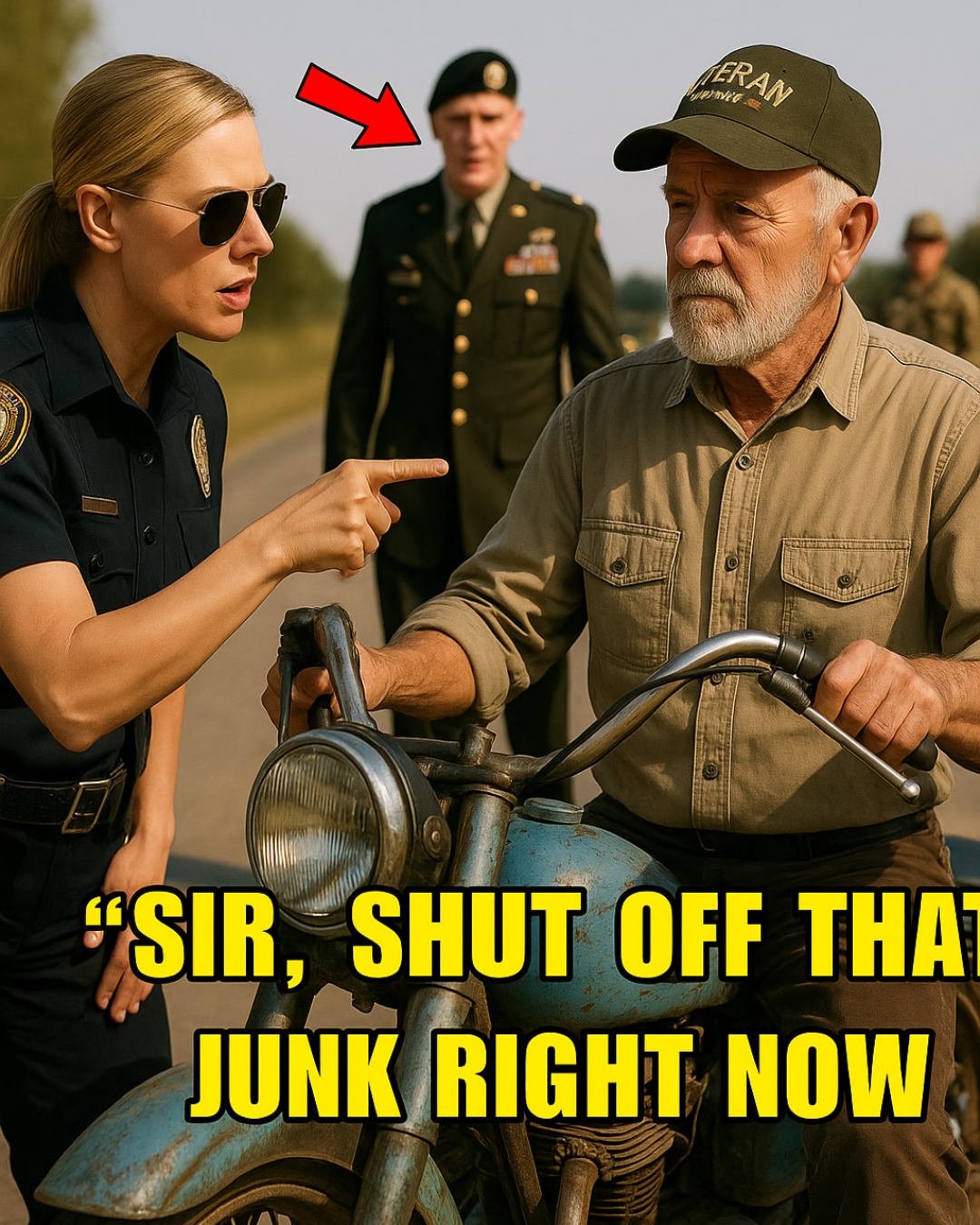Cops Pull Over a ‘Standard’ Motorcycle — But It Wasn’t Just Another Rider
On a quiet rural highway, local police officers flagged down a man riding a vintage motorcycle. What seemed like a routine traffic stop quickly turned tense. The rider—a grey‑bearded, khaki‑clad veteran wearing a ‘VETERAN’ cap—was accused of driving “junk,” and officers treated him as a suspicious figure. He was cuffed and humbled, while a nearby decorated military officer watched from a distance, the red arrow in the background signaling his looming presence.
What the officers didn’t know: they’d stopped the wrong man. Unbeknownst to them, this veteran had served decades of honorable duty, with stories of sacrifice and valor known only to a few.
A Sudden Shift: Military Power Rolls In
Within minutes of the confrontation, the scene changed dramatically. A convoy of around 50 soldiers in Humvees stormed in under the command of a U.S. Army Captain. The missing man, now identified, inspired unwavering loyalty; this Captain had once fought alongside him, and the silence shattered the moment their vehicles arrived
Instead of a simple traffic stop, a lesson in authority, respect, and misjudgment unfolded. The Captain’s arrival demanded accountability: “Which of you put hands on my man?”
YouTube
. The officers were left speechless—this was no ordinary biker.
Soldiers formed a protective perimeter, the Humvees’ presence overshadowing the small-town officers. It became clear that this veteran’s reputation held far more weight than any appearance could betray.
From Mistake to Reckoning: The Human and Institutional Fallout
As tensions cooled, the veteran was released unharmed—but the ripple effects began. The incident was not just about misidentification—it became a symbol of deeper issues:
Racial and age-based profiling: The wrongful stop echoed broader patterns of bias where surface-level assumptions override deeper truths. Officers judged the man by how he looked—not who he was
Power and protection in systems: The Captain’s swift intervention reflected a chain of respect and obligation forged on the battlefield. Civil law enforcement found itself unprepared against organized military authority.
Community oversight and reform: Public reaction to the incident sparked calls for policy changes, better identification protocols, and anti-profiling training—from both law enforcement and public advocacy groups.
Lessons Learned & Broader Context
1. Verify Before You Act
Cops must confirm identities—not just go by appearance—to avoid harmful mistakes. Similar real-world cases show that wrongful stops can escalate severely. A recent Alaska incident saw a man tasered and attacked with a dog simply because he shared a surname with a suspect—details police never verified properly
People.com
2. Respect Built on Real Service Matters
This veteran was not defined by his motorcycle or his appearance, but by decades of service. Military affiliation carries weight, and in this case, compelled a rapid response. The honor given to him by his fellow servicemembers transcended any law enforcement protocol.
3. Cross-Agency Boundaries
What happens when law enforcement stops a person with military connections? Agencies may operate independently, but authority overlaps—and in this story, the military intervention shifted the power dynamic immediately.
Visual Narrative: Key Moments Illustrated
Stopping the Veteran: Officers confront a humble older man on a motorbike.
Background Tension: The decorated military officer advances under a red arrow.
Sudden Arrival: Lines of Humvees roll in; soldiers disembark.
Confronting Authority: The Captain demands explanations from the police.
Resolution & Reflection: The veteran walks away with dignity; the town watches as the convoy departs.
Community & Cultural Impact
The story spread quickly—through local media, online forums, and news outlets—prompting broader discussion on:
Veteran treatment and respect
Police training around identity verification
How communities respond when systems of justice collide
Why It Resonates
Emotional reversal: A humble veteran is stopped unjustly, only to be defended by those who owe him everything.
Power dynamics: Civilians and military forces intersect unexpectedly—and the latter prevail.
Social commentary: Highlights contrast between surface judgment and lived honor.
Conclusion
What began as a simple traffic stop became a charged moment of reckoning in a community. A veteran’s dignity, brushed off by officers, was restored by his peers. The incident shows how authority, respect, and validation can diverge from what’s visible—and how identity checks and personal histories matter.
Would you ride into that scene? It’s a powerful reminder: never judge by the surface, and always verify before acting.


